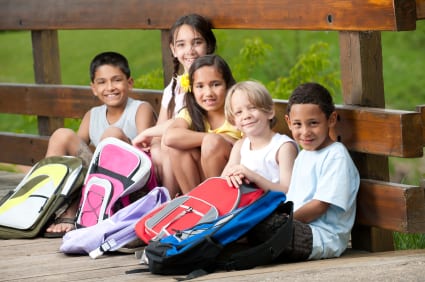TGIS – Thank Goodness It’s (almost) September!
Parents rejoice, children groan. No matter how you feel about the end of summer va-cay, it’s definitely time to start gearing up for the start of a new school year. So, in between shopping for endless supplies (do I really need to buy more glue sticks?!) and the latest must-have fashions, take a few minutes to review some safety tips as we get ready for the next 10 months of school activities, sports & after-school programs, playdates, and everything else in between. Here are some helpful tips for older kids, as well as some good, timely reminders for parents!
1. No “Right Age”
There’s no “right” age for when kids can walk or bike to school on their own. Consider the maturity level of your own child. Can they be trusted to cross streets safely? Would they know what to do if a car pulled over and tried to engage them in conversation? Or if an older child tried to bully them?
2. Buddy System
Kids should use the buddy system. It’s more fun and a lot safer.
3. Plan Out the Route
If your child walks to school on their own, plan out the route ahead of time and practice it with them a few times first. Always stick to the route. No short cuts.
4. “Safe-Stops”
Identify some “safe-stops” along the way. A convenience store, business, or friend’s home along the way where they can run to if they need help.
5. No Distractions
Kids shouldn’t walk to school wearing headphones, playing their DS, etc. Teach them the importance of always being aware of their surroundings.
6. Check Megan’s Law Website
Check your state’s Megan’s Law website to see if there are any registered sex offenders living on your route or in the area.
7. Use “Safe-Smarts”
Use your “safe-smarts”: No accepting rides, candy, gifts or other items from people they don’t know – NO MATTER WHAT THAT PERSON TELLS THEM.
8. Safe Grownups Don’t Ask Kids for Help
Kids don’t have to “assist” strangers who need directions, help finding a lost pet, or any other kind of assistance.
9. Check First
Never accept a ride or go somewhere (even with someone they know!), without checking in with you or another safe grownup first.
10. Plain, Common Sense Language
Review personal safety concepts with plain, common sense language – not fear tactics. Kids will “tune us out” when they think we are overprotective or harping on this subject. Let them know that you value their sense of independence and just want to be sure they’re clear on the “do’s & don’t’s”.
For All Kids
Remind your child to trust their instincts: that “uh-oh” feeling. If anyone EVER makes them feel uncomfortable, they need to get away from that person and tell you as soon as possible.
No secrets from Mom or Dad, especially if it makes you feel “weird” or yucky.
Kids are allowed to say NO to anyone, even a grownup, a teacher, sports coach, etc. if they’re asked to do something that makes them feel yucky, scared, or uncomfortable. If someone says “Don’t tell…”, they MUST tell.
For Parents
Remember, the world is still a safe place and most people that our children interact with are not dangerous or waiting to hurt them when we’re not looking. Teach safety skills in an easy-going, non-fearful manner, just like you’d teach any other life skills. A little common sense goes a long way.





